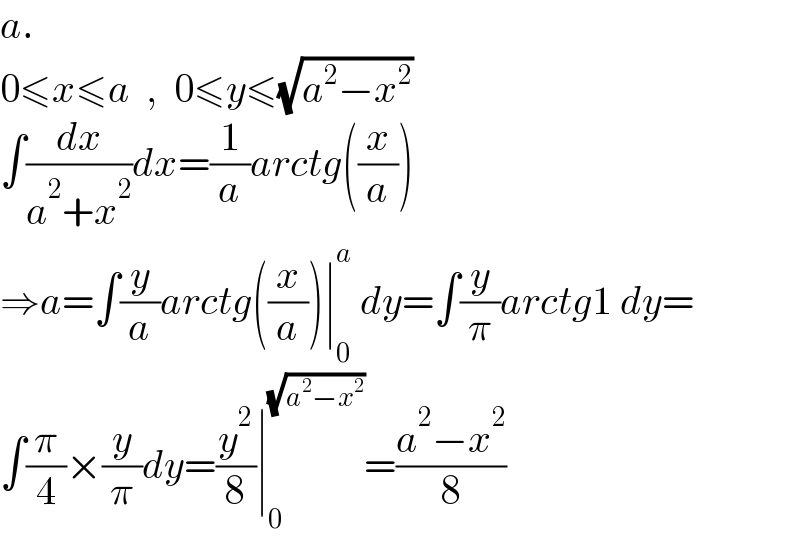
Question and Answers Forum
Question Number 170663 by kndramaths last updated on 28/May/22

Commented by kaivan.ahmadi last updated on 28/May/22

Answered by Mathspace last updated on 29/May/22
![A=∫∫_D (y/(x^2 +a^2 ))dx dy we do the changement x=arcosθ et y=arsinθ ⇒ x^2 +y^2 ≤a^2 ⇒a^2 r^2 ≤a^2 ⇒0≤r≤1 x≥0 and y≥0 ⇒0≤θ≤(π/2) ⇒A=∫∫_(o≤r≤1 and o≤θ≤(π/2)) ((arsinθ)/(a^2 r^2 cos^2 θ+a^2 ))a^2 rdrdθ =a∫∫_(o≤r≤1 and 0≤θ≤(π/2)) ((r^2 sinθ)/(1+r^2 cos^2 θ))dr dθ =∫_0 ^1 (∫_0 ^(π/2) ((r^2 sinθ)/(1+r^2 cos^2 θ))dθ)dr but ∫_0 ^(π/2) ((r^2 sinθ)/(1+r^2 cos^2 θ))=_(rcosθ=u) =∫_r ^0 ((−rdu)/(1+u^2 ))=r∫_0 ^r (du/(1+u^2 )) =rarctanr ⇒ A=∫_0 ^1 r arctan(r)dr =[(r^2 /2)arctanr]_0 ^1 −∫_0 ^1 (r^2 /2)(dr/(1+r^2 )) =(π/8)−(1/2)∫_0 ^1 ((1+r^2 −1)/(1+r^2 ))dr =(π/8)−(1/2) +(1/2)∫_0 ^1 (dr/(1+r^2 )) =(π/8)−(1/2)+(π/8)=(π/4)−(1/2)](Q170680.png)
Commented by Mathspace last updated on 29/May/22

Answered by Mathspace last updated on 29/May/22
![C=∫∫∫_V xy dxdy dz we do the changement x=rcosθ y=rsinθ ⇒C=∫_0 ^1 (∫∫_w xydxdy)dz x^2 +y^2 ≤z^2 ⇒o≤r≤z ⇒ ∫∫_w xy dx dy=∫∫_(o≤r≤zand o≤θ≤2π) (rcosθ)(rsinθ)r drdθ =∫_0 ^z r^3 dr ∫_0 ^(2π) cosθsinθ =(z^4 /8)∫_0 ^(2π) sin(2θ)dθ =(z^4 /8)[−(1/2)cos(2θ)]_0 ^(2π) =0⇒C=0](Q170682.png)
